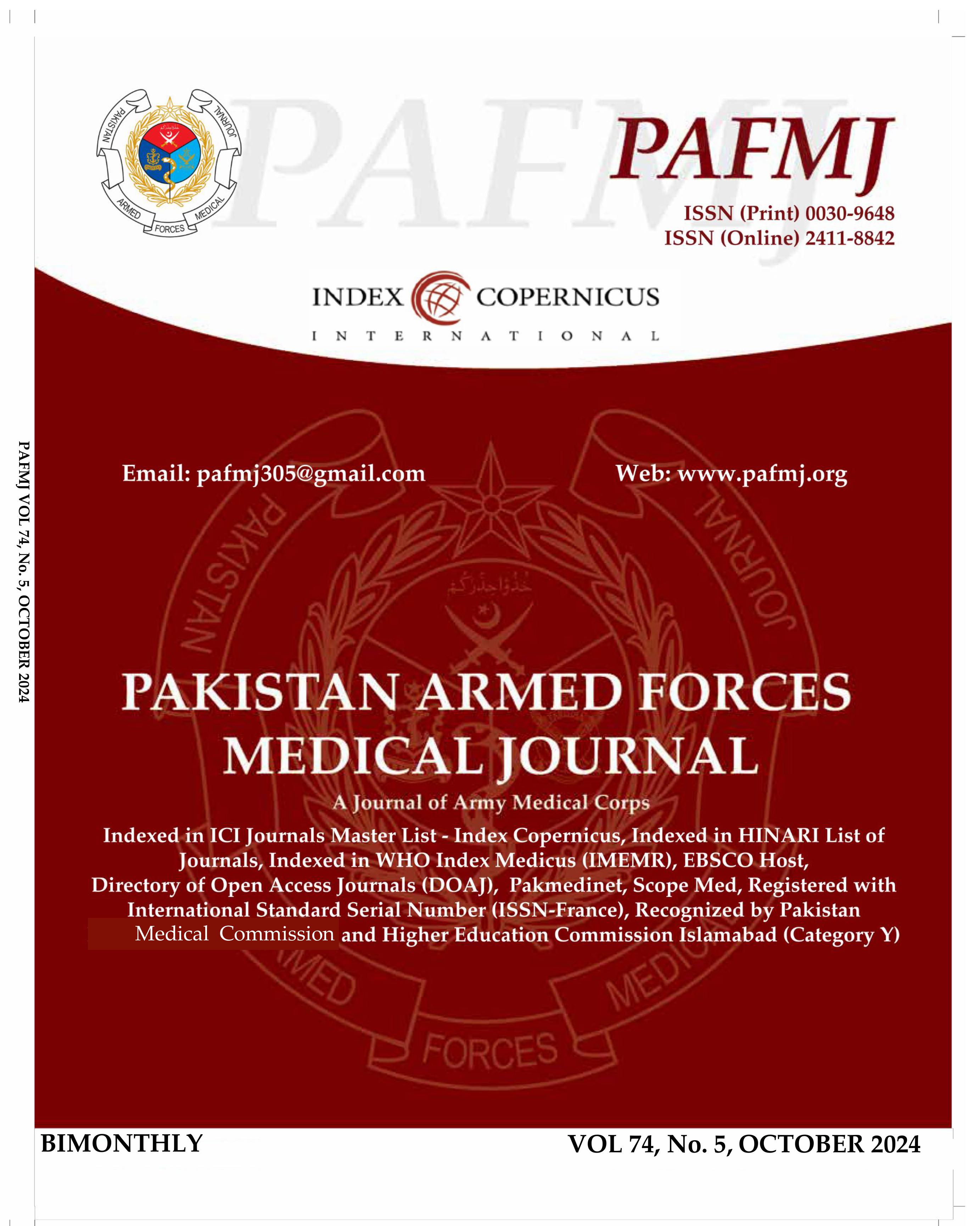Comparison of The Postoperative Outcomes of Surgical Lateral Internal Sphincterotomy and Botulinum Toxin Injection in Patients Presenting With Chronic Anal Fissure At CMH, Rawalpindi
DOI:
https://doi.org/10.51253/pafmj.v74i5.8449Keywords:
Botulinum Toxin Injection; Chronic Anal Fissure; Lateral Internal SphincterotomyAbstract
Objective: To compare the postoperative outcomes in Lateral Internal Sphincterotomy Group and in Botulinum toxin injection Group in patients managed for chronic anal fissure.
Study Design: Quasi-experimental study.
Place and Duration of Study: Department of Surgery, Combined Military Hospital, Rawalpindi Pakistan, from Aug 2021 to Feb 2022.
Methodology: All patients of either gender, aged 30 to 70 years, who had presented to CMH, were included in this study. Block randomization was done to allocate half of them to Lateral Internal Sphincterotomy and half to Botulinum toxin injection. Patients in both Groups were followed for four weeks to assess and compare various short and long term post-surgical outcomes.
Results: There were 82 patients in total with 41 in each treatment arm. In the Lateral Internal Sphincterotomy Group, 35 85(37%) of the patients reported postoperative pain relief at 24 hours, 39(95.12%) patients healed, only 2(4.88%) patients had a recurrence. In the Botulinum toxin Group, 29(70.73%) reported postoperative pain relief at 24 hours, 35(85.37%) patients healed, whereas 6(4.63%) had a recurrence. There was no statistical difference in any parameter between either Group.
Conclusion: Both methods did not show any statistically significant difference in post-operative outcomes thus other parameters like patient’s choice, cost and expertise may be considered in treatment of chronic anal fissure.
Downloads
References
Salati SA. Anal Fissure - an extensive update. Pol Przegl Chir 2021; 93(4): 46-56.
https://doi.org/10.5604/01.3001.0014.7879
Wilson MZ, Swarup A, Wilson LR, Ivatury SJ. The effect of nonoperative management of chronic anal fissure and hemorrhoid disease on bowel function patient-reported outcomes. Dis Colon Rectum 2018; 61(10): 1223-1227. https://doi.org/10.1097/DCR.0000000000001193
Anandaravi B, Ramaswami B. Closed versus open lateral internal anal sphincterotomy in a chronic anal fissure. Int Surg J 2017; 4(3): 1055-1058.
https://doi.org/10.18203/2349-2902.isj20170861
D'Ugo S, Franceschilli L, Cadeddu F, Leccesi L, Blanco GDV, Calabrese E, et al. Medical and surgical treatment of haemorrhoids and anal fissure in Crohn’s disease: a critical appraisal. BMC Gastroenterol 2013; 13(1): 1-7.
https://doi.org/10.1186/1471-230X-13-47
Ebinger SM, Hardt J, Warschkow R, Schmied BM, Herold A, Post S, et al. Operative and medical treatment of chronic anal fissures-a review and network meta-analysis of randomized controlled trials. J Gastroenterol 2017; 52(6): 663-676.
https://doi.org/10.1007/s00535-017-1335-0
Samalavicius NE, Smolskas E, Klimasauskiene V, Mikuzis S, Dulskas A. Lateral Internal Sphincterotomy for chronic anal fissure under perianal anaesthetic infiltration - a video vignette. Colorectal Dis 2020; 22(5): 593-594.
https://doi.org/10.1111/codi.14941
Lee KH, Hyun K, Yoon SG, Lee JK. Minimal Lateral Internal Sphincterotomy (LIS): Is It Enough to Cut Less Than the Conventional Tailored LIS?. Ann Coloproctol 2021; 37(5): 275-280.
https://doi.org/10.3393/ac.2020.00976.0139
Al-Thoubaity F. Safety and efficacy of the treatment of chronic anal fissure by Lateral Internal Sphincterotomy: A retrospective cohort study. Ann Med Surg (Lond) 2020; 57: 291-294. https://doi.org/10.1016/j.amsu.2020.08.010
Cakir C, Idiz UO, Aydin I, Firat D, Ulusoy Aİ, Yazici P. Comparison of the effectiveness of two treatment modalities for chronic anal fissure: Botox versus sphincterotomy. Turk J Surg 2020; 36(3): 264-270.
Amorim H, Santoalha J, Cadilha R, Festas MJ, Barbosa P, Gomes A. Botulinum toxin improves pain in chronic anal fissure. Porto Biomed J 2017; 2(6): 273-276.
Ahmad MS, Amin I, Kareemullah M, Bashir S, Sattar Z, Hanif A. Outcome of Botulinum toxin with Lateral Internal Sphincterotomy for treatment of chronic anal fissure. Pak J Med Health Sci 2012; 8(3): 901-904.
Rashad AM, Nafady HA, El-Gaabary TM. Comparative study between surgical Lateral Internal Sphincterotomy and Botulinum toxin injection in the treatment of chronic anal fissure. Egypt J Surg 2020; 39(4): 1242.
Kujur ADS, Paul Ekka NM, Chandra S, Lal S, Malua S. Comparative Study to Assess the Effectiveness of Topical Nifedipine and Diltiazem in the Treatment of Chronic Anal Fissure. J Family Med Prim Care 2020; 9(11): 5652-5657.
Soltany S, Hemmati HR, Toussy JA, Salehi D, Toosi PA. Therapeutic properties of Botulinum toxin on chronic anal fissure treatment and the patient factors role. J Family Med Prim Care 2020; 9(3): 1562-1566.
Ooijevaar RE, Felt-Bersma RJF, Han-Geurts IJ, van Reijn D, Vollebregt PF, Molenaar CBH. Botox treatment in patients with chronic functional anorectal pain: experiences of a tertiary referral proctology clinic. Tech Coloproctol 2019; 23(3): 239-244. https://doi.org/10.1007/s10151-019-01945-8
Arroyo A, Pérez F, Serrano P, Candela F, Lacueva J, Calpena R. Surgical versus chemical (Botulinum toxin) sphincterotomy for chronic anal fissure: long-term results of a prospective randomized clinical and manometric study. Am J Surg 2005; 189(4): 429-434.
Giral A, Memişoğlu K, Gültekin Y, İmeryüz N, Kalaycı C, Ulusoy NB, et al. Botulinum toxin injection versus Lateral Internal Sphincterotomy in the treatment of chronic anal fissure: a non-randomized controlled trial. BMC Gastroenterol 2004; 4(1): 1-6.
Schouten WR, Briel JW, Auwerda JJ. Relationship between anal pressure and anodermal blood flow. Dis Colon Rectum 1994; 37(7): 664-669.
Menteş BB, Irkörücü O, Akın M, Leventoğlu S, Tatlıcıoğlu E. Comparison of Botulinum toxin injection and Lateral Internal Sphincterotomy for the treatment of chronic anal fissure. Dis Colon Rectum 2003; 46(2): 232-237.
Downloads
Published
Issue
Section
License
Copyright (c) 2024 Syeda Rifaat Qamar Naqvi, Saadan Saleem, Mansoor Tariq Azim, Aimen Luqman, Malik Muhammad Jalil, Khurram Sarfraz

This work is licensed under a Creative Commons Attribution-NonCommercial 4.0 International License.















